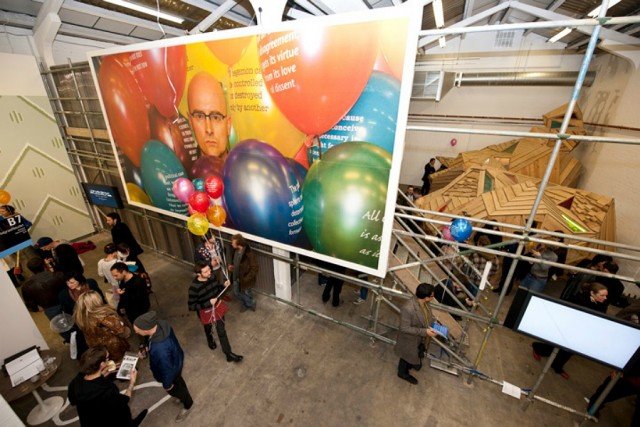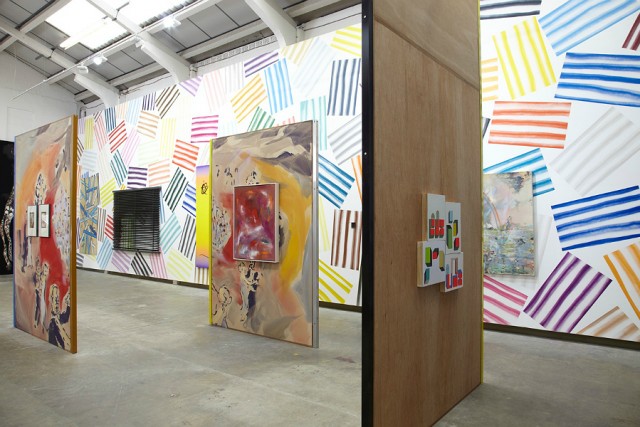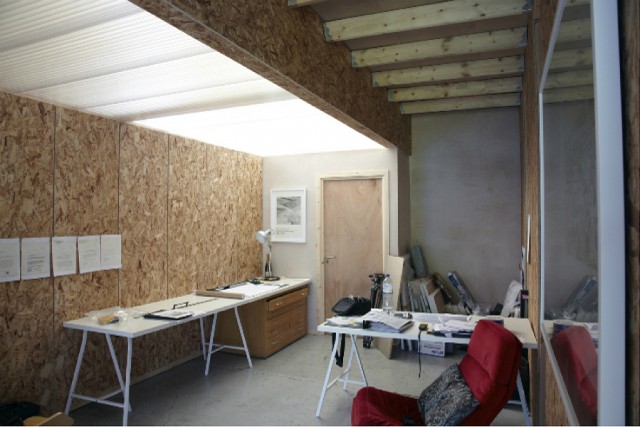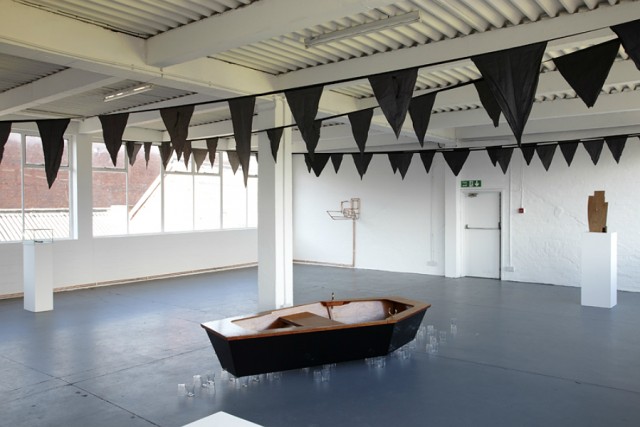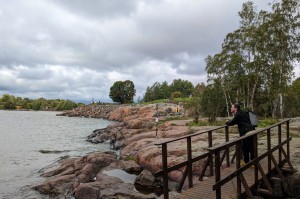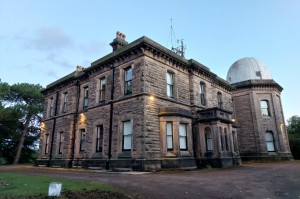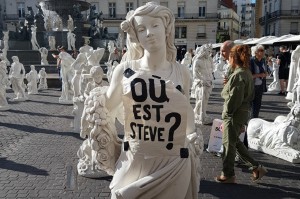Field Trip #6: Birmingham
Painter Andrew Foulds visits Birmingham, a city with an art scene punching above its weight…
It is 10:04am, I am one in a gang of seven dishevelled Liverpool artists standing on a platform at Birmingham New Street station. We are here to visit three artist-led spaces, somewhere on the outskirts of the city centre. I’m hoping one of the other six knows where they are going.
Making our way out of the station we walk through a grubby shopping arcade called The Strand, same name, same smell as the Bootle Strand. I make a mental note – are all Strand’s owned by the same person? I glance around for a fancy dress superstore but don’t see one. Slightly disappointed, I run to catch up with the others.
Outside now and the sky is crystal clear, there is a bitterly cold breeze. It is early February and there are still patches of snow on the ground; the hairs in my nose stand on end and my buttocks automatically clench as if to squeeze all the warm blood deeper inside. We find ourselves in the central shopping district and walk past three Costas, two Starbucks and a McDonalds.
On the train, my anticipation had been steadily building. Never having visited Birmingham I listened to the views of those who had and formed the impression of a city in a state of change, away from dull grey concrete and the malaise of fallen industry, towards a progressive metropolis, focussed on commercial growth. I was hoping to find a city caught in a heady mix between the two; that dangerous cocktail where the broken-down becomes ripe for transformation.
The main shopping street in Birmingham is wide, straight and long. The width of this street and its elevated position above the rest of the city creates a powerful vista as you glance down the road and see it seemingly disappear about a hundred yards in front. Centred in this gap is the spire of a church which I was reliably informed is ‘Saint Martins in the Bullring’. I wondered whether this was a description of his martyrdom; maybe he just fell in by accident and someone shouted “Martin’s in the Bullring!” and the name stuck. As you draw nearer you realise the rest of the church sits at the bottom of some steps, marking a rather sharp cut-off point to where the rest of the city begins. On your left the infamous Selfridges building reveals itself, the exterior looking like an architect forgot to take the bubble-wrap off before he left. Looming above the church, Selfridges appears as a shimmering mirage in a crude symbolic gesture, an allegory for when a new religion overthrows the old.
Five minute’s walk further out of the centre and a very different personality reveals itself. The crumbling bricks left behind by the Industrial Revolution in the 18th and 19th centuries take over from the shiny facade of today’s commercial focus. Markedly more rundown, the tenacious adaptability of the local population is evident. Almost every dilapidated building appears to be inhabited in some way: mechanics, grocers, antique stores, second-hand and vintage shops (actually selling jumpers for 50p!). A myriad of small scale enterprises have established themselves and seemingly thrive, clinging to the edge of existence here.
We arrive at Eastside Projects, a gallery with a unique perspective and the first of three venues we aim to visit during the day. Since their first show in September 2008, Eastside Projects has established itself as one of the most exciting, progressive and critically challenging art venues anywhere in the UK. With a healthy pot of funding and a strong identity, it has proven that artists are able to create venues which can “punch emphatically above their weight” and compete directly with any of the larger public institutions. I was excited about the prospect of seeing Painting Show, an exhibition lauded in the national press. I was particularly impressed by the bravery of the curation, or more accurately, non-curation. Each piece was selected without concern for an over-arching theme, but on the merits of its success as a painting alone. If it was a feast of painting, Henry VIII would have been stuffed. Paintings hung high, paintings hung low, paintings hung in front of other larger paintings, paintings as wallpaper and paintings in frames.
It showed that the two curators, Sophie Von Hellerman and Gavin Wade, are both artists and Painting Show benefitted hugely from their relaxed approach. Rather than fleshing-out with an unnecessary contextual depth, the curator/artists confidence in letting the paintings speak for themselves made for a richer experience. All the concerns present in contemporary painting practice were evident in the works, so why stifle that by fitting them into a prescribed curatorial bowl?
The unique philosophy of Eastside Projects reflects itself in the ever evolving and changing appearance of the gallery as a whole. Artworks chosen for past exhibitions have become long-term fixtures in the gallery; through a process of recycling its remains, “the space writes and records its own history. Each new addition responds to and alters the existing conditions. The gallery accumulates the traces of its use as part of a learning process”. This learning process is not seen as autonomous; to those in charge it has a social function and is of benefit to all. These lofty ambitions set Eastside Projects apart from many generic white cube galleries, just as the philosophy embeds it within the community and immediate locale of Birmingham, so it raises Eastside Projects to international significance.
It is a short walk to the next venue on our list. The Lombard Method is a set of studios and project spaces housed in a large ramshackle brick building not dissimilar to Liverpool’s own Wolstenholme Creative Space. Like WCS, The Lombard Method organise events rich with the allure of the impermanent and tinged with a sense of the cult. By gaining admittance you get that intoxicating feeling of being part of a secret group, one of the select few privy to these underground activities. At the time of our visit there was no exhibition, although we wanted to take the opportunity to wander around the studio, speak to a few people and generally be a bit nosey. Talking with Joe Weldon, one of the founding members, it was apparent that Birmingham is benefitting from a dynamic and talented crop of recent graduates. Erudite and thoughtful, he described Lombard Method’s origins, similarities in the working philosophy of its members, their successful residency programme, and how they are considering applying for their first Arts Council grant. It remains to be seen what path The Lombard Method choose to take. The freedom without funding has allowed ideas to grow organically; this unforced element to their practice has fed into the aesthetic of their events, and it will be interesting to see if they are able to hold onto their individualistic identity if they do decide to go down the funding route.
Last on our list of places to visit was Grand Union, an industrial unit which has been renovated to house eight purpose-built studios and a project space. On show at the time of our visit was a solo exhibition by the Glasgow based artist Torsten Lauschmann called Before the Revolution. I will mention one great work, Life Like, which grabbed my attention. To experience it in real-time is to feel like you have been shot straight back to the birth of cinema, watching as shadows dance and leap across the walls.
A particularly interesting aspect to Grand Union is the custom built studios. With a healthy amount of financial support from Birmingham City Council (are you listening LCC?), Grand Union employed the architects Queen and Crawford to design practical, economical and (crucially in a large warehouse) a warm series of studios. Like a street of terraced houses, the studios sit side-by-side, with front doors opening onto a public corridor. This means that each studio feels like its own space; a system which would not appeal to everyone but I for one was impressed. It felt like a working, professional environment, which sometimes the more open plan studio’s can fail to replicate.
Coming to the end of our visit – and maybe the free falafel I received in a sandwich shop tainted my objective view – I left Birmingham feeling incredibly positive and reenergised about the possibilities available not only here, but in Liverpool as well. There are undoubted similarities between the cities. Much like Liverpool, there are many poverty-stricken areas; the fall of industry had a huge impact, though there is a general focus now on the future. The art scene is small, but it punches above its weight. The work being produced, whether in the creation of galleries or as artists’ individual practice, is vibrant, professional and ambitious. I would advise anyone to visit Birmingham; there are many lessons we can learn which will help in our activities closer to home. We could all do much worse than use Eastside Projects as a litmus test to assess our own ambitions and ask: are we doing enough to challenge the status-quo, are we relevant?
Andrew Foulds
Images courtesy Stuart Whipps for Eastside Projects, and courtesy Grand Union

